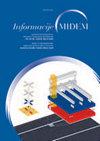A Memetic based Approach for Routing and Wavelength Assignment in Optical Transmission Systems
IF 0.8
4区 工程技术
Q4 ENGINEERING, ELECTRICAL & ELECTRONIC
Informacije Midem-Journal of Microelectronics Electronic Components and Materials
Pub Date : 2019-05-07
DOI:10.33180/infmidem2019.102
引用次数: 2
Abstract
In optical networks, Routing and Wavelength Assignment (RWA) problem is one of the major optimization problems. This problem can be solved by different algorithms such as Genetic Algorithm (GA), Artificial Bee Colony (ABC), Ant Colony Optimization (ACO), etc. Shuffled Frog Leaping Algorithm (SFLA) is implemented in the proposed work, to solve the RWA problem in long-haul optical networks. The goal is to use minimum number of wavelengths and to reduce the number of connection request rejections. Cost, number of wavelengths, hop count and blocking probability are the performance metrics considered in the analysis. Various wavelength assignment methods such as first fit, random, round robin, wavelength ordering and Four Wave Mixing (FWM) priority based wavelength assignment are used in the analysis using SFLA. Number of wavelengths, hop count, cost and setup time are included in the fitness function. The SFLA algorithm proposed, has been analyzed for different network loads and compared with the performance of genetic algorithm.基于模因的光传输系统路由和波长分配方法
在光网络中,路由和波长分配(RWA)问题是主要的优化问题之一。该问题可以通过遗传算法(GA)、人工蜂群算法(ABC)、蚁群优化算法(ACO)等不同的算法来解决。为了解决长距离网络中的RWA问题,本文采用了shuffle Frog leapalgorithm (SFLA)。目标是使用最少的波长数,并减少连接请求被拒绝的次数。成本、波长数、跳数和阻塞概率是分析中考虑的性能指标。在SFLA分析中使用了各种波长分配方法,如首次拟合、随机、轮循、波长排序和基于四波混频(FWM)优先级的波长分配。适应度函数包括波长数、跳数、成本和设置时间。分析了该算法在不同网络负载下的性能,并与遗传算法进行了性能比较。
本文章由计算机程序翻译,如有差异,请以英文原文为准。
求助全文
约1分钟内获得全文
求助全文
来源期刊
CiteScore
1.80
自引率
0.00%
发文量
10
审稿时长
>12 weeks
期刊介绍:
Informacije MIDEM publishes original research papers in the fields of microelectronics, electronic components and materials. Review papers are published upon invitation only. Scientific novelty and potential interest for a wider spectrum of readers is desired. Authors are encouraged to provide as much detail as possible for others to be able to replicate their results. Therefore, there is no page limit, provided that the text is concise and comprehensive, and any data that does not fit within a classical manuscript can be added as supplementary material.
Topics of interest include:
Microelectronics,
Semiconductor devices,
Nanotechnology,
Electronic circuits and devices,
Electronic sensors and actuators,
Microelectromechanical systems (MEMS),
Medical electronics,
Bioelectronics,
Power electronics,
Embedded system electronics,
System control electronics,
Signal processing,
Microwave and millimetre-wave techniques,
Wireless and optical communications,
Antenna technology,
Optoelectronics,
Photovoltaics,
Ceramic materials for electronic devices,
Thick and thin film materials for electronic devices.

 求助内容:
求助内容: 应助结果提醒方式:
应助结果提醒方式:


